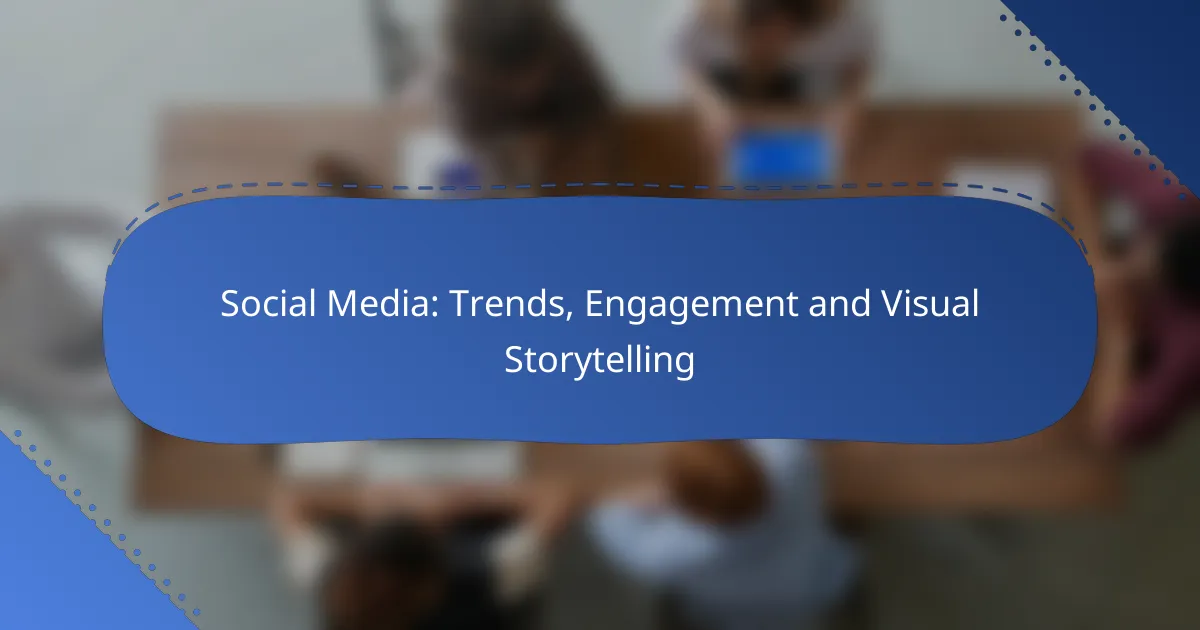In 2023, social media is evolving with trends such as short-form video content and a focus on authenticity, reshaping how brands connect with their audiences. To enhance engagement, brands are leveraging interactive and user-generated content, alongside influencer partnerships. Visual storytelling plays a pivotal role in this landscape, as it effectively captures attention and communicates messages through compelling images and videos.
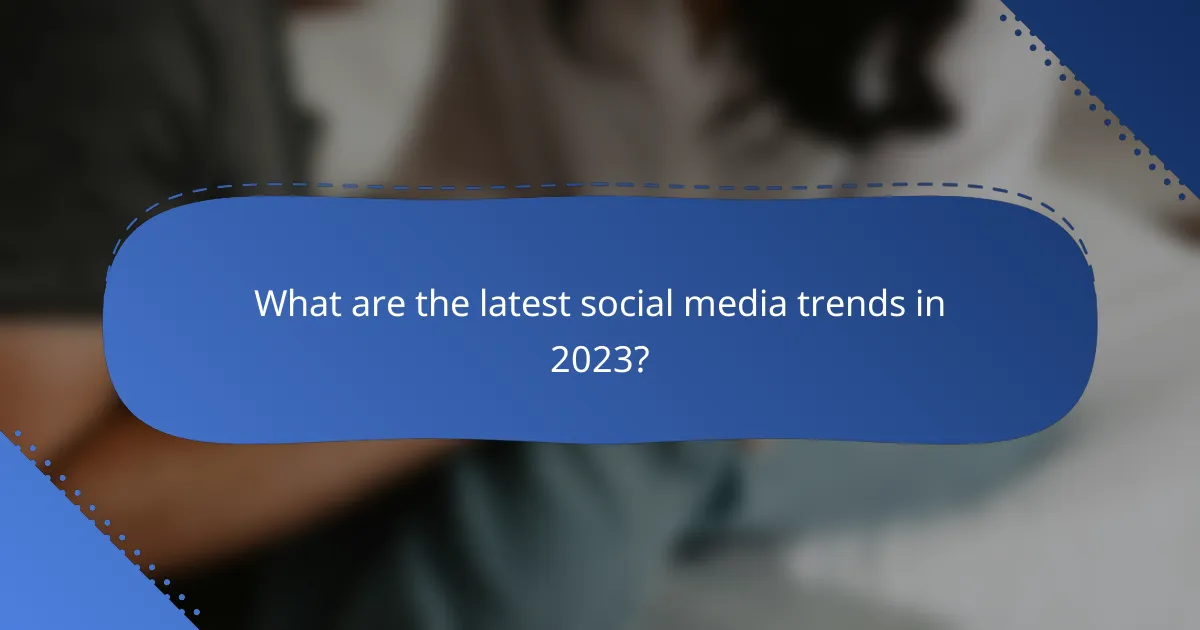
What are the latest social media trends in 2023?
In 2023, social media trends are heavily influenced by the rise of short-form video content, a growing emphasis on authenticity, and the expansion of social commerce. These trends reflect changing user preferences and technological advancements that shape how brands engage with their audiences.
Rise of short-form video content
Short-form video content continues to dominate social media platforms, with users favoring quick, engaging clips over longer formats. Platforms like TikTok and Instagram Reels have popularized this trend, encouraging brands to create concise videos that capture attention within seconds.
To leverage this trend, brands should focus on storytelling that is visually compelling and easily digestible. Aim for videos that are under 60 seconds, using eye-catching visuals and clear messaging to convey key points quickly.
Increased focus on authenticity
Authenticity is becoming a crucial factor in social media engagement, with users gravitating towards genuine content that reflects real experiences. Brands that showcase their values and engage transparently with their audience tend to build stronger connections.
To enhance authenticity, brands should share behind-the-scenes content, user-generated material, and stories that resonate with their target audience. Avoid overly polished content that may come off as insincere; instead, embrace imperfections that reflect true brand identity.
Growth of social commerce
Social commerce is rapidly expanding, allowing users to shop directly through social media platforms. This trend is driven by the convenience of discovering products within familiar environments, making it easier for brands to convert engagement into sales.
Brands should integrate shopping features into their social media strategies, utilizing shoppable posts and live shopping events. Ensure that the purchasing process is seamless to enhance user experience and drive conversions.
Emergence of new platforms
New social media platforms are emerging, offering unique features that attract different demographics. These platforms often focus on niche interests or innovative content formats, providing opportunities for brands to reach untapped audiences.
Brands should stay informed about these new platforms and consider early adoption strategies. Engaging with early users can help establish a presence before the platform becomes saturated, allowing for more effective audience targeting.
Integration of augmented reality
Augmented reality (AR) is increasingly being integrated into social media experiences, enhancing user interaction and engagement. AR features, such as filters and virtual try-ons, allow users to interact with products in a more immersive way.
Brands should explore AR tools to create engaging campaigns that encourage user participation. Consider developing AR filters or experiences that align with your brand identity, making it easier for users to visualize products in their own context.
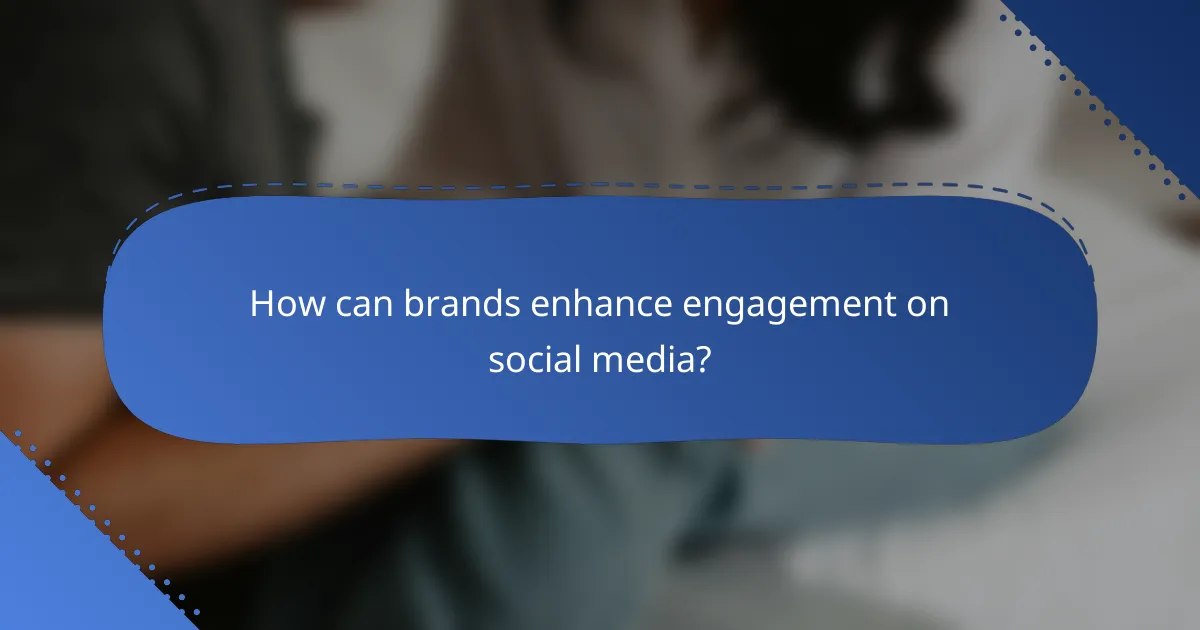
How can brands enhance engagement on social media?
Brands can enhance engagement on social media by creating content that resonates with their audience and encourages interaction. This can be achieved through various strategies, including interactive content, user-generated content, and influencer partnerships.
Utilizing interactive content
Interactive content, such as polls, quizzes, and live videos, invites users to participate actively rather than passively consuming information. This type of content can significantly increase engagement rates, as it encourages followers to share their opinions and experiences.
To effectively utilize interactive content, brands should consider their audience’s preferences and interests. For instance, a fashion brand might create a style quiz to help users discover their fashion personality, while a tech company could host a live Q&A session about their latest product.
Implementing user-generated content strategies
User-generated content (UGC) involves encouraging customers to share their own experiences with a brand’s products or services. This not only fosters community but also builds trust, as potential customers often view UGC as more authentic than traditional advertising.
Brands can implement UGC strategies by creating specific hashtags for customers to use or by running contests that incentivize sharing. For example, a travel company might ask users to post their vacation photos with a branded hashtag, showcasing real experiences and enhancing brand visibility.
Leveraging influencer partnerships
Partnering with influencers can amplify a brand’s reach and engagement by tapping into the influencer’s established audience. Influencers can create authentic content that resonates with their followers, making it more likely for the audience to engage with the brand.
When leveraging influencer partnerships, brands should choose influencers whose values align with their own and who have a genuine connection with their audience. For instance, a health food brand might collaborate with a fitness influencer to promote healthy eating habits, ensuring the content feels organic and relatable.

What role does visual storytelling play in social media?
Visual storytelling is crucial in social media as it captures attention and conveys messages more effectively than text alone. By using images, videos, and graphics, brands can create engaging narratives that resonate with their audience and enhance overall communication.
Enhances emotional connection
Visual storytelling fosters emotional connections by evoking feelings through imagery and narrative. When users see relatable visuals, they are more likely to engage with the content, leading to deeper relationships with the brand. For example, a charity organization sharing images of beneficiaries can create empathy and motivate donations.
To maximize emotional impact, consider using authentic images that reflect real experiences. Avoid stock photos that may feel generic or disconnected from the audience’s reality.
Increases shareability of content
Content that incorporates visual storytelling tends to be more shareable across social media platforms. Eye-catching visuals can grab attention in crowded feeds, prompting users to share with their networks. Infographics, for instance, are often shared because they present complex information in an easily digestible format.
To enhance shareability, ensure visuals are high-quality and relevant to current trends. Including a call-to-action can also encourage users to share the content with their followers.
Improves brand recall
Visual storytelling significantly improves brand recall by associating memorable images with the brand message. Studies show that people retain information better when it is presented visually, making it easier for them to remember a brand after seeing its content. For example, brands that use consistent color schemes and logos in their visuals create stronger associations in consumers’ minds.
To boost brand recall, maintain a cohesive visual identity across all platforms. This includes using similar styles, colors, and themes that reflect the brand’s personality, making it instantly recognizable to the audience.
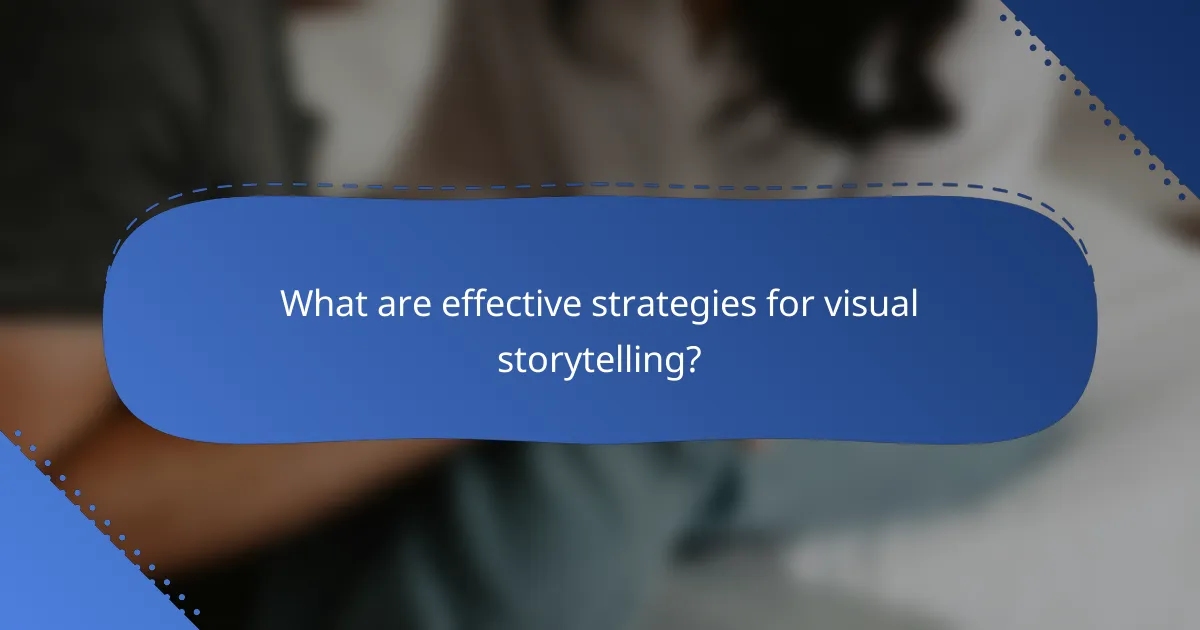
What are effective strategies for visual storytelling?
Effective strategies for visual storytelling involve using engaging visuals to convey messages clearly and emotionally. This approach enhances audience connection and retention, making content more memorable and impactful.
Using high-quality images and videos
High-quality images and videos are essential for capturing attention and conveying professionalism. Aim for visuals that are sharp, well-composed, and relevant to your message. Consider using tools like Adobe Lightroom or Canva to enhance your images before sharing them.
When selecting videos, ensure they are well-edited and optimized for the platform you are using, whether it’s for social media or a website. Short, engaging clips often perform better than longer formats, especially on platforms like Instagram and TikTok.
Incorporating infographics
Infographics are powerful tools for presenting complex information in an easily digestible format. They combine visuals with data to tell a story, making it easier for viewers to grasp key points quickly. Use clear headings, concise text, and relevant icons to enhance understanding.
When creating infographics, focus on a single theme or message to avoid overwhelming your audience. Tools like Piktochart or Venngage can help you design effective infographics that align with your branding.
Creating compelling narratives
Compelling narratives are crucial for engaging your audience emotionally. Start with a strong hook that draws viewers in, followed by a clear storyline that includes challenges and resolutions. This structure keeps the audience invested in the content.
Consider using personal stories or case studies to illustrate your points. This approach not only humanizes your brand but also creates relatability, encouraging viewers to connect with your message on a deeper level.
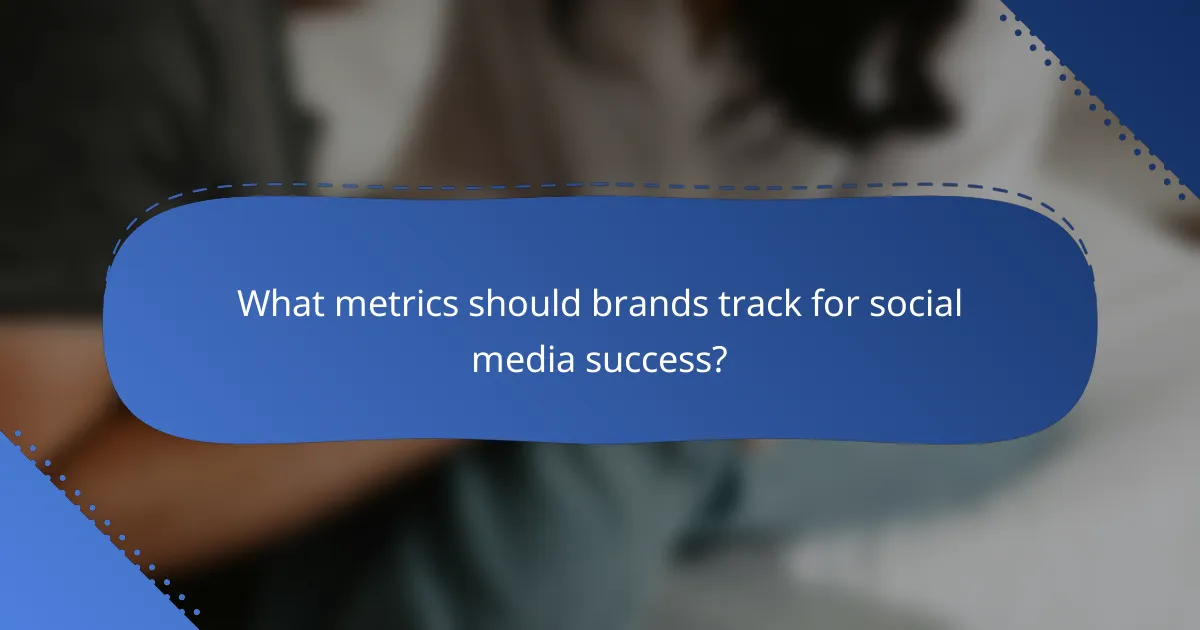
What metrics should brands track for social media success?
Brands should focus on key metrics such as engagement rate, reach, and impressions to gauge their social media success. These metrics provide insights into how well content resonates with the audience and the overall effectiveness of social media strategies.
Engagement rate
Engagement rate measures the level of interaction that content receives from users, typically expressed as a percentage of total followers or impressions. It includes likes, shares, comments, and other forms of interaction, indicating how compelling the content is to the audience.
To calculate engagement rate, divide the total engagements by the total reach or followers, then multiply by 100. A good engagement rate generally falls between 1% and 5%, but this can vary by industry and platform.
Brands should aim to create content that encourages interaction. Avoid overly promotional posts, as they tend to receive lower engagement. Instead, focus on storytelling, asking questions, or sharing user-generated content to boost engagement.
Reach and impressions
Reach refers to the total number of unique users who see a post, while impressions count the total number of times a post is displayed, regardless of whether it was clicked or not. Understanding both metrics helps brands assess the visibility of their content.
High reach indicates that content is being seen by many users, which is essential for brand awareness. Impressions can be significantly higher than reach, especially if users see the same post multiple times. Brands should monitor these metrics to evaluate the effectiveness of their campaigns and adjust their strategies accordingly.
To improve reach, consider using targeted ads or collaborating with influencers. Regularly posting at optimal times for your audience can also enhance visibility. Avoid posting too frequently, as this can lead to audience fatigue and diminish overall impressions.
